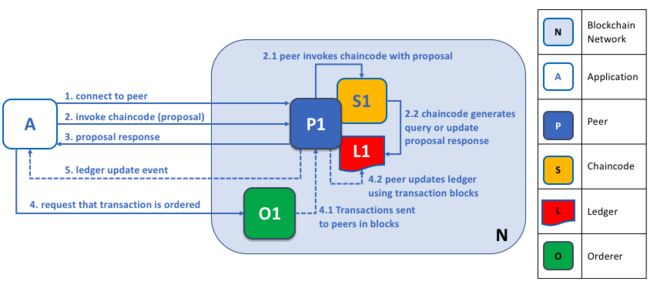How applications interact with peers to access the ledger?
- Ledger-query interactions involve a simple three-step dialogue between an application and a peer.
- Ledger-update interactions are a little more involved and require two extra steps.
We simplify these steps a little to gain a better understanding of Hyperledger Fabric query and update model. What is most important to understand is the difference in application-peer interactions for ledger-query compared to ledger-update transaction styles.
Applications always connect to peers when they need to access ledgers and chaincodes. The Fabric Software Development Kit (SDK) makes this easy for programmers. Its APIs enable applications to connect to peers, invoke chaincodes to generate transactions, submit transactions to the network that will get ordered and committed to the distributed ledger, and receive events when this process is complete.
Through a peer connection, applications can execute chaincodes to query or update a ledger. The result of a ledger query transaction is returned immediately, whereas ledger updates involve a more complex interaction between applications, peers and orderers.
Peers, in conjunction with orderers, ensure that the ledger is kept up-to-date on every peer. In this example, application A connects to P1 and invokes chaincode S1 to query or update the ledger L1. P1invokes S1 to generate a proposal reponse that contains a query result or a proposed ledger update. Application A receives the proposal response and, for queries, the process is now complete. For updates, A builds a transaction from all of the responses, which it sends it to O1 for ordering. O1 collects transactions from across the network into blocks and distributes these to all peers, including P1. P1 validates the transaction before applying to L1. Once L1 is updated, P1 generates and event, received by A, to signify completion.
A peer can return the results of a query to an application immediately since all of the information required to satisfy the query is in the peer's local copy of the ledger. Peers never consult with other peers in order to respond to a query from an application. Applications can, however, connect to one or more peers to issue a query; for example, to corroborate a result between multiple peers, or retrieve a more up-to-date result from a different peer if there's a suspicion that information might be out of date. In the diagram, you can see that ledger query is a simple three-step process.
An update transaction starts in the same way as a query transaction, but has two extra steps. Although ledger-updating applications also connect to peers to invoke a chaincode, unlike with ledger-querying applications, an individual peer cannot perform a ledger update at this time, because other peers must first agree to the change — a process called consensus. Therefore, peers return to the application a proposed update — one that this peer would apply subject to other peers’ prior agreement. The first extra step — step four — requires that applications send an appropriate set of matching proposed updates to the entire network of peers as a transaction for commitment to their respective ledgers. This is achieved by the application using an orderer to package transactions into blocks, and distribute them to the entire network of peers, where they can be verified before being applied to each peer’s local copy of the ledger. As this whole ordering processing takes some time to complete (seconds), the application is notified asynchronously, as shown in step five.
